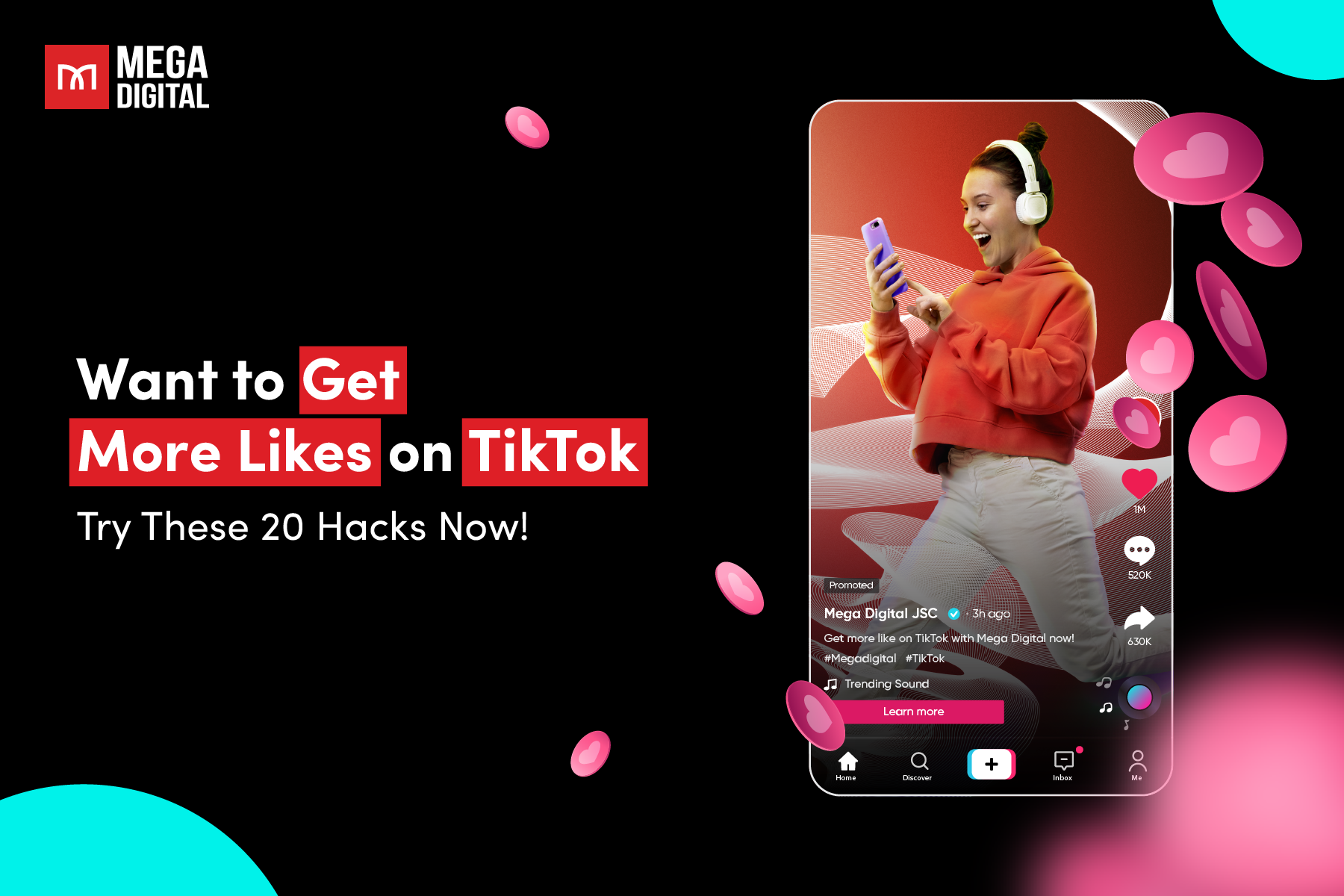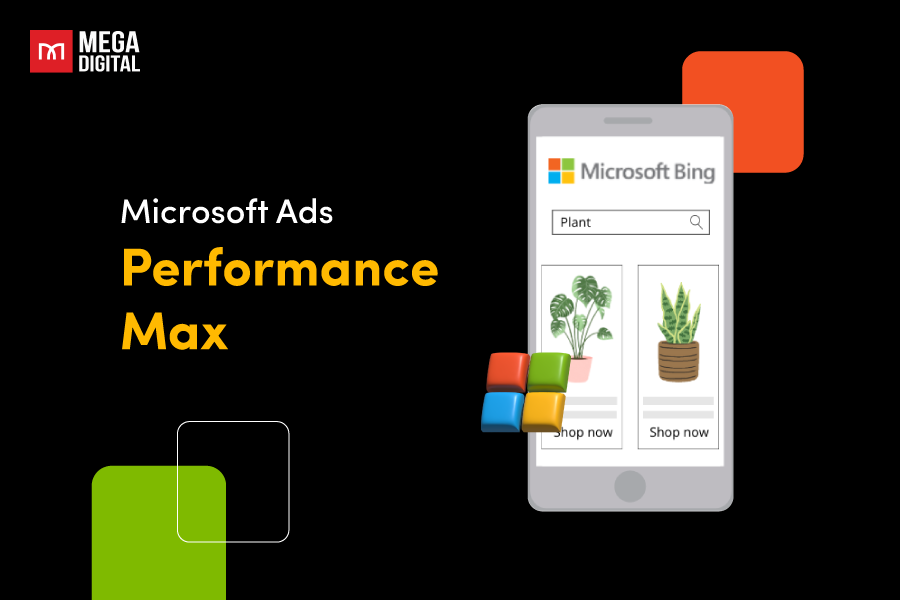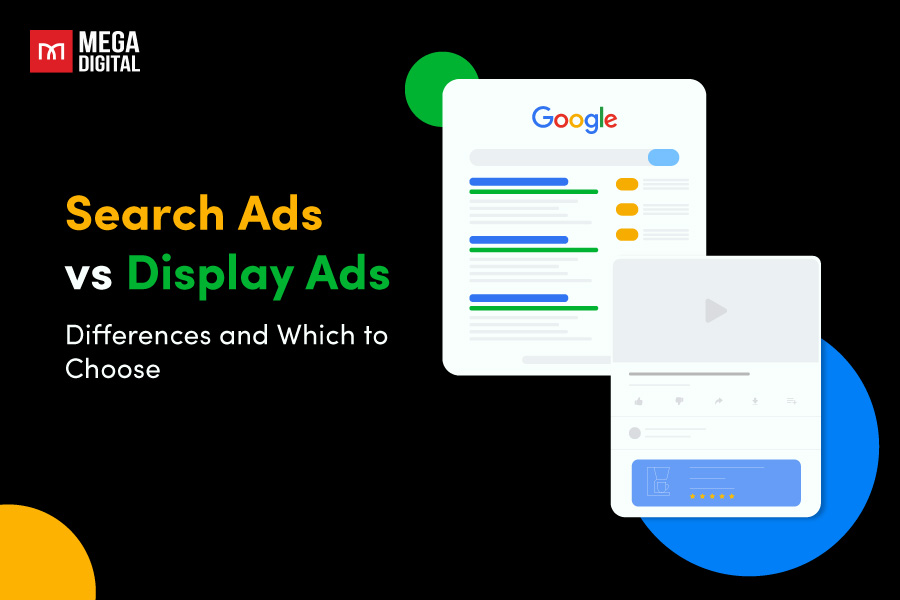Choosing the right ad types when running campaigns on Facebook is crucial as it can greatly enhance the effectiveness of the campaign, ensuring that the ads reach the intended audience and achieve the desired outcomes. Are you confused by all the different types of Facebook Ads and unsure which suits your business the most? Check out this blog to get yourself familiar with all the Facebook ad types, along with practical tips on how to decide on the right one.
Why you should advertise on Facebook?
Advertising on Facebook offers numerous advantages for businesses looking to expand their reach and connect with their target audience. Here are several compelling reasons why advertising on Facebook is beneficial:
A large and diverse audience
Facebook has over 2.8 billion monthly active users, making it one of the largest social media platforms globally. This vast user base provides businesses with the opportunity to reach a diverse audience across different demographics, interests, and geographic locations.
Precise targeting options
Facebook’s advertising platform offers robust targeting options, allowing businesses to define their audience based on factors such as age, gender, location, interests, behaviors, and more. This precision helps ensure that ads are shown to the most relevant audience for the campaign objectives.
Engagement and interaction
Facebook is a platform where users actively engage with content. Advertisers can leverage this engagement by creating interactive and shareable content, encouraging users to like, comment, share, and interact with the brand.
Cost-effective advertising
Facebook advertising is often cost-effective, particularly for businesses with limited budgets. Advertisers can set daily or lifetime budgets, control bid strategies, and optimize campaigns based on performance, maximizing the return on investment.
Versatile ad formats
Facebook supports a variety of ad formats, including image ads, video ads, carousel ads, slideshow ads, etc., which will be explained in detail right below. This versatility allows businesses to choose the format that best suits their content and goals, making campaigns more engaging and visually appealing.
All types of Facebook ads you need to know
Facebook offers different types of Facebook ads to help businesses achieve their specific goals when advertising on this platform. Here are the main types of Facebook ads and Facebook Ads Sizes you need to know:
Photo Ads
Facebook Photo Ads, or Image Ads, feature a high-quality still image along with a text copy and a call to action (CTA) button. These are the simplest forms of ads, and among the the most common ones that I bet you must have seen a lot when you scroll through your Facebook newsfeed. You can use boosted posts or create dedicated ads for photo ads.
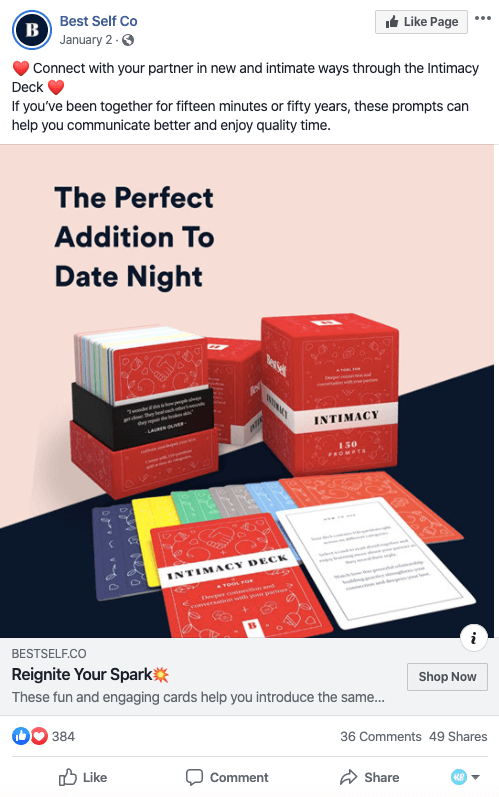
A single image often speaks louder about your business positioning and goals than pages full of text, facts, and statistics. Facebook image ads are a powerful tool for achieving various campaign objectives. Whether you want to increase brand awareness, drive traffic, or promote products, image ads can help you reach your target audience and deliver your message.
Specifications:
- For image:
- Size: at least 1080 x 1080 pixels
- Ratio: should be between 1.91:1 to 1:1
- File types: should be JPG or PNG
- For text description:
- Primary text: should be 125 characters
- Headline: should be 27 characters
- Description: should also be 27 characters.
Video Ads
Facebook Video Ads are pretty much the same as image ads, with the difference being the media. Facebook video ads are a type of online advertising that uses video content to promote a product, service, or brand on Facebook and its partner platforms under Meta. Video ads can run in News Feed and Stories or appear as in-stream ads in longer Facebook videos.
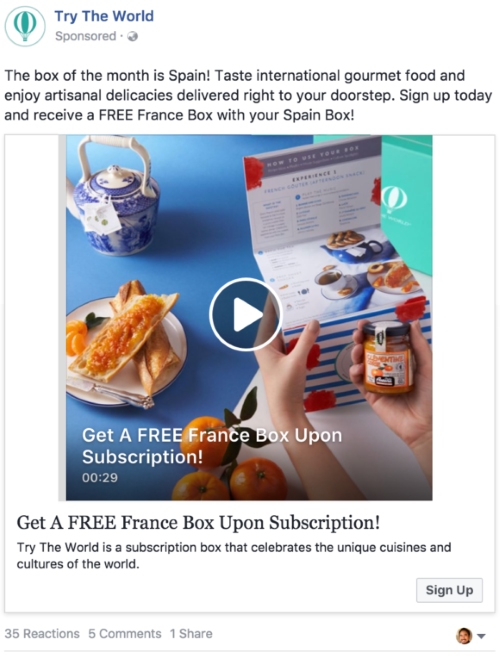
Video ads are more captivating and engaging than image ads. Businesses can use them to demonstrate a product, explain a service, or convey a brand’s personality. Every month, over 1.25 billion users watch videos on the platform, and they devote nearly 50% of their app time to video viewing. However, video production can be more difficult and costly.
Specifications:
- The recommended video settings are H.264 compression, square pixels, fixed frame rate, progressive scan, and stereo AAC audio compression at 128kbps+.
- The resolution should be at least 1080 x 1080 pixels.
- The video duration can be 1 second to 241 minutes.
- The maximum file size is 4GB.
Stories Ads
Facebook Stories Ads are a type of advertisement that appears in the Stories section at the top of users’ News Feeds on mobile devices. These ads are placed sandwiched between organic content from a user’s friends and family. Stories ads appear in vertical format, so keep that in mind when creating images and videos for this Facebook ad type.
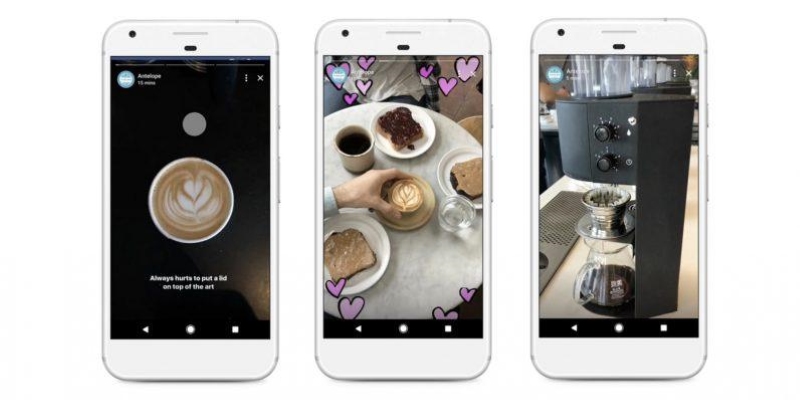
The primary element of Facebook Stories ads is visual content. Advertisers can use a combination of images and short videos to convey their message. These visuals are meant to capture the attention of users as they tap through Stories. The recommended duration is up to 15 seconds, ensuring that the content is concise and holds the viewer’s interest within the short time frame.
Facebook Stories ads seamlessly integrate across multiple platforms, including Facebook, Instagram, and Messenger. Advertisers can create a single Stories ad and choose to display it on these interconnected platforms.
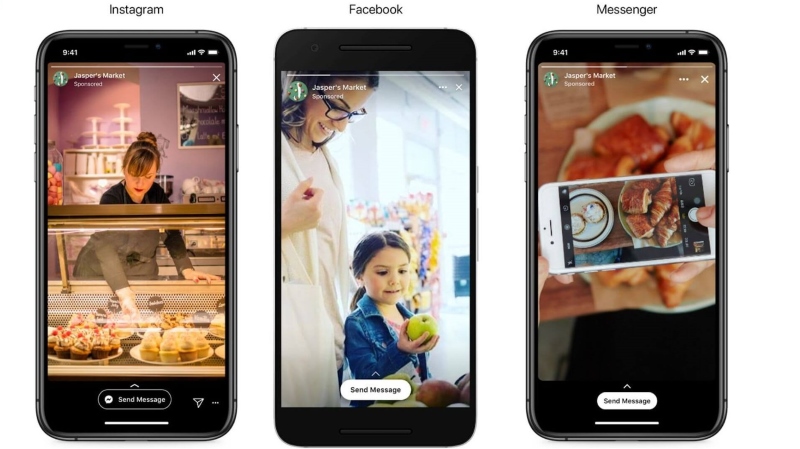
Reels Ads
Reels ads are short-form video advertisements that appear within the Facebook Reels feed. They allow businesses to showcase their products, services, or brand stories in a dynamic and engaging format that captures user attention while they scroll through the platform’s Reels section. These ads can blend seamlessly with organic Reels content, offering advertisers a prime opportunity to engage users, enhance brand visibility, foster engagement, and drive conversions.
There are 2 main types of Facebook Reels ads:
- Overlay ads: These are automatically rendered at the bottom of reels content in the form of a single static banner or carousel of images.
- Post-loop ads: These are standalone and skippable video ads that appear after a reel has finished. Upon the completion of the ad, the partner’s reel resumes and loops again.
Please note that only one overlay ad or post-loop ad can be delivered on a single reel.
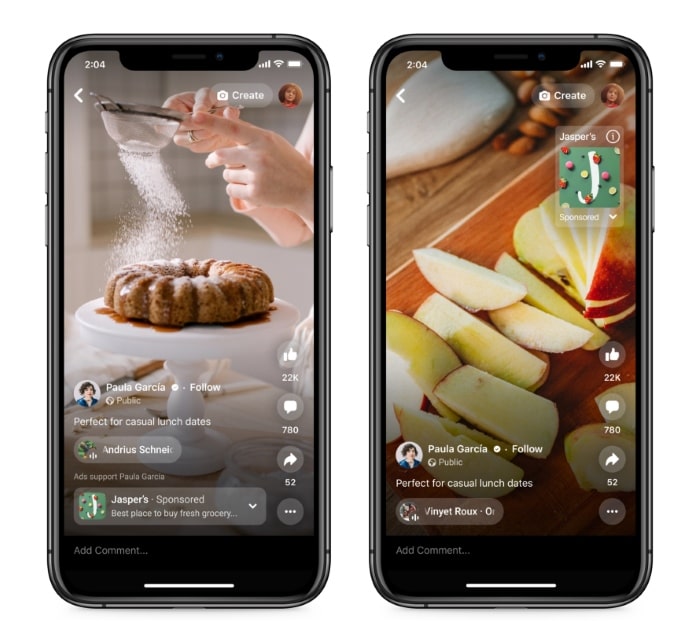
Specifications:
- File type: MP4, MOV.
- Ratio: 9:16.
- Video settings: H.264 compression, square pixels, fixed frame rate, progressive scan, and stereo AAC audio compression at 128kbps+.
- Resolution: At least 500 x 888 px.
- Video duration: from 0 seconds to 15 minutes.
- Maximum file size: 4GB.
- Video captions and sound: Optional, but highly recommended.
Carousel Ads
Carousel Ads are a type of ads that allows businesses to showcase up to 10 images or videos within a single ad. When users stumble upon these ads, they can swipe through a series of images or videos horizontally. Each card in the Carousel can link to a different destination URL. Advertisers can guide users to specific product pages, landing pages, or other relevant content based on the content of each card.
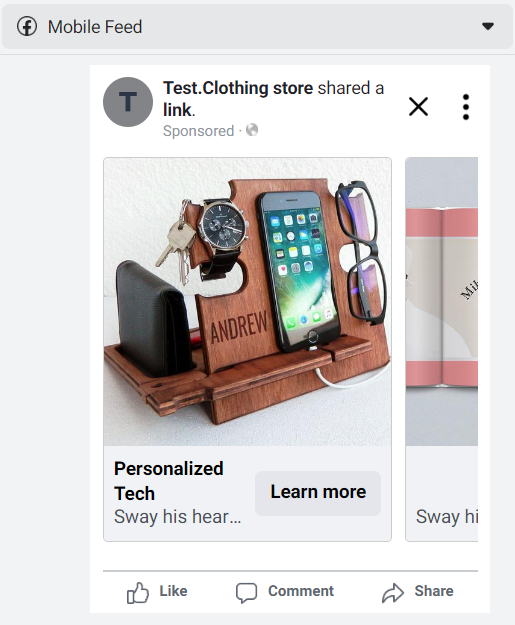
This ad type provides more creative space within an ad, allowing businesses to highlight different products, showcase specific details about one product, service, or promotion, or even tell a story about their brand that develops across each carousel card.
Slideshow Ads
Slideshow Ads are a video-like ad format that plays as a short video clip but is created using a series of images or a combination of images and videos. They have eye-catching motion, just like videos, but use five times less data, so they load well even for people on slow internet connections.
Facebook slideshows are the perfect option when you don’t want to go for a video ad, or simply don’t have enough video production resources. Or, if you have high-performing Facebook image ads, you may consider turning them into a slideshow video ad. You can do all of this within Facebook, as well as add stock photos and music for some variety.
Slideshow Ads are effective for product showcases, allowing advertisers to highlight different features, use cases, or variations of a product within a short, visually appealing sequence.
Specifications:
- Slideshow Ads can include 2 to 15 still images or videos. Each slide can either contain videos, photos, or even stock images.
- Your images should be at least 1,080 x 1,080 pixels and have an aspect ratio of either 16:9 or 1:13.
Collection Ads
Collection Ads allow users to discover, browse, and purchase products directly from their News Feed. These ads have a main featured image or video, as well as 2 (or more) smaller images underneath. When someone clicks on a collection ad, they’re taken to an Instant Experience, a fullscreen landing page that drives engagement and nurtures interest.
As the name suggests, these ads enable you to display an entire product collection, bridging the gap between discovery and purchase. They offer extensive customization options and are especially effective if you want to display a diverse range of products.
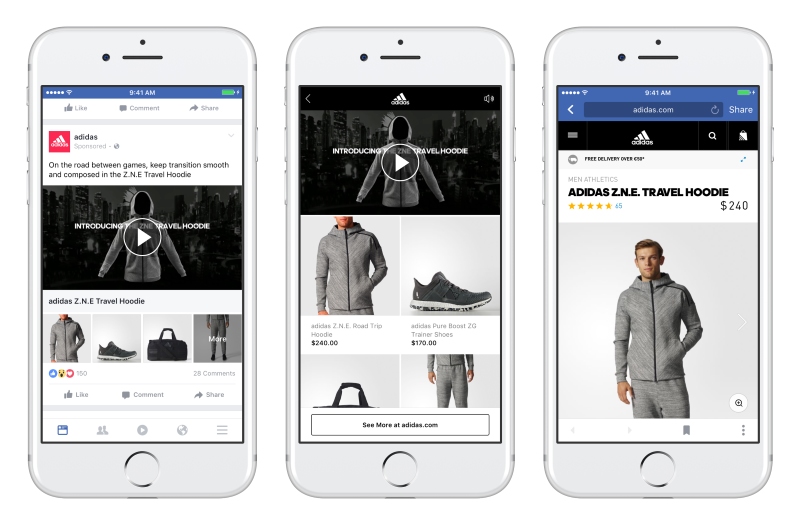
There are different templates available for your collection ad:
- Instant Storefront: This template is best for showcasing more than four products in your catalog. You can display your products in a grid so people can browse them in one place.
- Instant Lookbook: The lookbook template is a godsend for brands that want to tell a story and show their catalog in action. It’s ideal for creating a digital version of an existing print catalog.
- Instant Customer Acquisition: This template hooks your ad into a mobile-optimized landing page. It’s perfect when you want to drive conversions on your mobile landing page and want people to take a specific action on your website or app.
Messenger Ads
Messenger Ads allow businesses to connect with users directly through Facebook Messenger. They appear in the Messenger app’s home screen as well as in between Messenger Stories and can be used to start conversations or drive traffic to your website.
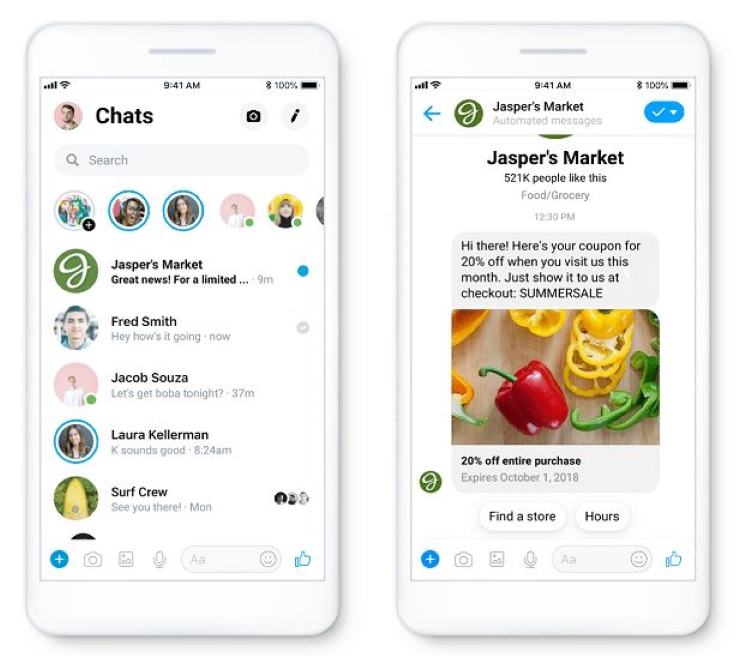
Lead Ads
Lead Ads are a type of advertisement designed to collect user information, such as email addresses and phone numbers, directly within the Facebook platform. They’re ideal for collecting newsletter sign-ups, booking appointments, or generating leads.
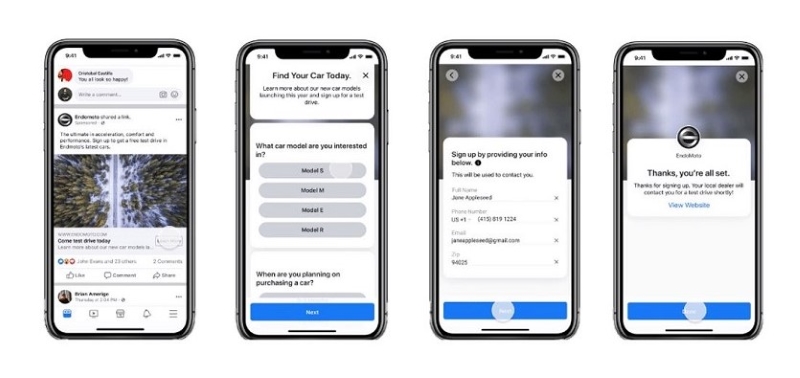
When users tap on your ad, a form pops up that’s already pre-populated with information for most of the fields a prospect would normally have to fill out manually. Since they’re pre-filled, people can easily “fill out” and submit a form containing their contact information. Lead Ads make it easy for people to provide their contact information without leaving the platform. By cutting out the redirecting to an external landing page, Facebook lead ads increase conversion by never compromising the user experience.
Dynamic Ads
Facebook Dynamic Ads are powered by a product catalog, which advertisers create and upload to Facebook. This catalog contains information about the products or services the business wants to promote, including images, descriptions, prices, and other relevant details. When someone visits your site and logs into Facebook, they’ll see an ad featuring the same products they were looking at on your website. As a result, the ads they see are incredibly personalized and relevant.
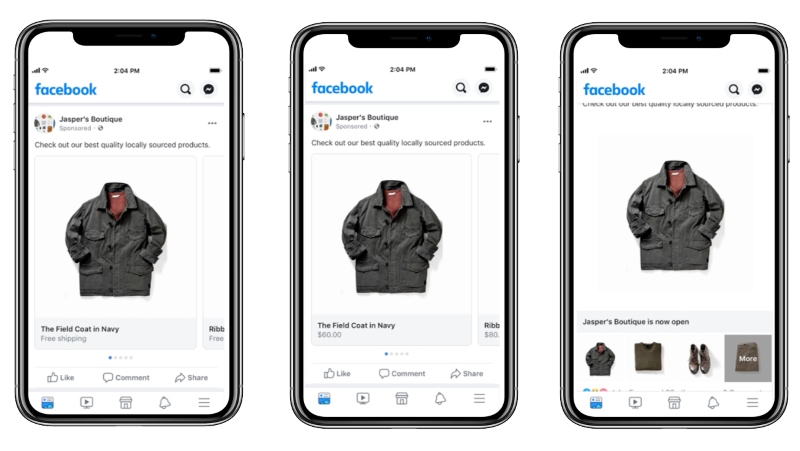
When you run a dynamic ad campaign, the text remains consistent for all viewers, while the visual content is entirely individualized and personalized, crafted based on each viewer’s specific interactions on your website.
Poll Ads
Facebook Poll Ads is an interactive ad format that allows businesses to engage their audience by asking a question with two possible answers. This particular Facebook ad type is typically effective for increasing engagement with your current audience and building brand awareness among potential new customers. You can create Facebook poll ads using either images or videos.
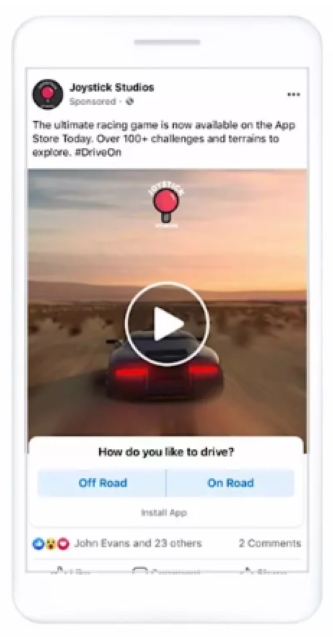
Here are some cases you should opt for this ad type:
- Gathering product feedback.
- Conducting market research for new products or service concepts.
- Understanding your customer preferences.
Playable Ads
Playable Ads offer users an interactive and engaging experience. The primary purpose of Playable Ads is to give users a preview or “try-before-you-install” experience. Users can interact with a brief segment of the game or app, providing a taste of the actual gameplay. This is especially common in the context of mobile gaming ads.
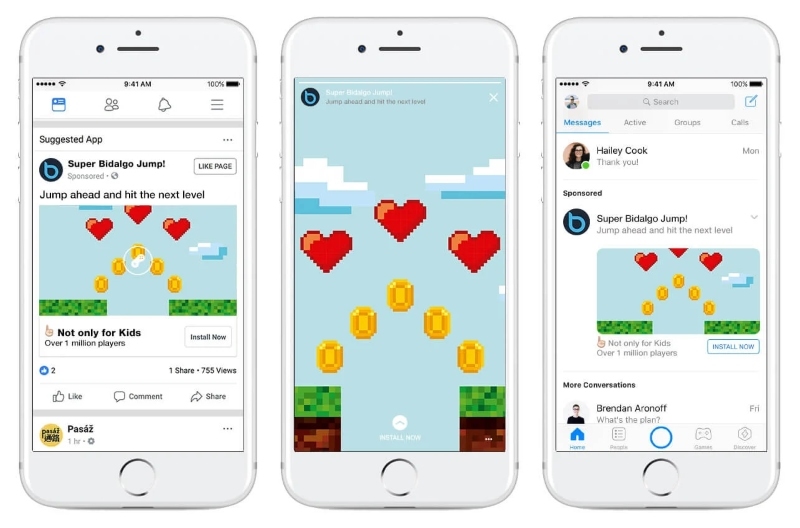
Augmented Reality Ads
Augmented Reality Ads are interactive ad options that offer a captivating experience for mobile users. The process is straightforward: when users encounter your ad in their feed and tap on it, they’re greeted with interactive hotspots and guidance on how to interact with the ad. This initiates an augmented reality (AR) experience, allowing users to explore your products virtually, gaining new perspectives and replicating the in-person shopping experience.
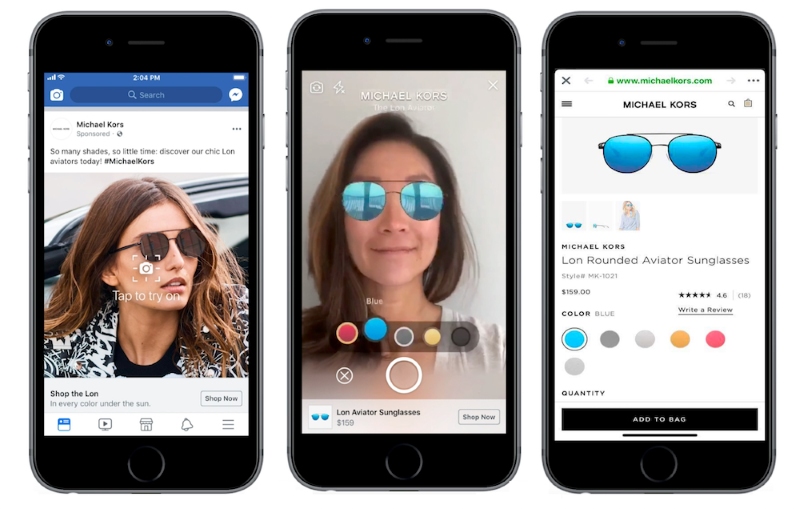
How to choose the right ad types on Facebook?
Choosing the right Facebook ad type is crucial for the success of your advertising campaign. Here are some detailed steps to guide you in making the right choice:
Define your campaign goal
The first step is to decide on the goal of your campaign. This could be increasing brand awareness, driving website traffic, generating leads, or boosting online sales. Your campaign goal will guide your choice of ad type, as different ad types are designed to achieve different objectives.
Understand the ad types
Familiarize yourself with the different Facebook ad types and their uses. Each ad type serves a unique purpose and is designed to help you achieve specific campaign goals. For instance:
- Image ads are simple but powerful that can be used for many purposes.
- Video ads can show your story in a more immersive way.
- Carousel ads can showcase up to 10 images or videos in a single ad, each with its own link, and so on.
Once you have defined your campaign goal and understood the different ad types, choose the ad types that are most relevant to your goal.
Target the right audience
After choosing the ad type, it’s important to target the right audience. Facebook provides advertisers with advanced targeting options that allow them to reach specific demographics, interests, behaviors, and locations. You can create a custom audience that represents your ideal customer based on their age, gender, location, interests, behaviors, and more.
Test, analyze, and repeat
Finally, it’s important to test your ads, analyze their performance, and make necessary adjustments along the way. This will help you understand what works best for your audience and optimize your ads for better performance. You can use Facebook’s powerful analytics tools to track the performance of your ads, understand how people are interacting with them, and identify areas for improvement.
Wrap-up
In conclusion, there are numerous types of Facebook Ads for you to choose from. Whether your goal is to increase brand awareness, boost website traffic, generate leads, or drive sales, there’s an ad type tailored to your objectives. From Image and Video ads to Carousel and Collection ads, you have a wide array of ad types to effectively reach and engage your target audience on Facebook. As you begin using Facebook Advertising, I hope you do great in expanding your audience and achieving your marketing goals.
Learn More: Simple walkthrough to create a Facebook ad account in 5 steps






